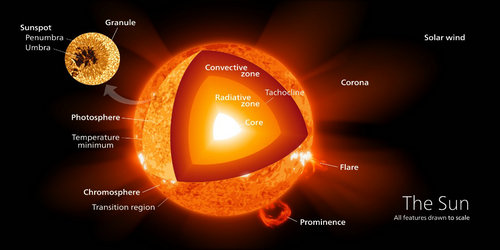LAMOST view of the temporal variability of stellar activity in young late-type stars
Recently, based on the LAMOST low-resolution spectra, Dr. Xiangsong Fang and Prof. Gang Zhao from National Astronomical Observatories of Chinese Academy of Sciences (NAOC), together with other collaborators, have carried out a systematic study of the temporal variability of stellar activity in young late-type stars. Their results have been published in the journal Monthly Notices of the Royal Astronomical Society.
As a late-type star with an age of about 4600 million years, the Sun has a variety of phenomena on its atmosphere, e.g., sunspots in the photosphere, the regions of reduced temperature (thus darker than the surrounding areas) caused by concentrations of magnetic field flux; and plages, the bright and intensely hot areas in the chromosphere, which are usually associated with sunspots; as well as other events like flares and prominences, as illustrated in the Figure below. Such phenomena are closely linked to the generation and evolution of magnetic fields in solar interior and atmosphere, and thus collectively referred to as the solar magnetic activity.
Stellar magnetic activity phenomena, analogous to the solar ones, are found to be ubiquitous in late-type stars. However, due to the limitation of current observational technology, astronomers are still unable to observe directly the magnetic activity of late-type stars other than the Sun. To understand stellar magnetic activity, astronomers have to rely on indirect observational facts, for instance, periodic changes in the stellar brightness and even spectral line profiles can be used to estimate the size and distribution of cool spots; the excess emission of chromospheric activity diagnostic spectral features are helpful to analyze the plage property; the sudden flash of brightness and the rapid changes of the spectral features caused by flares also provide good opportunity to understand the magnetic activities. With the observation of these magnetic activity phenomena, astronomers can uncover the mystery of the generation mechanism and evolution of the internal magnetic field of stars.
Generally speaking, stellar activity is related to the stellar structure and rotation rate, i.e., compared to old counterparts, the young, fast-rotating late-type stars have much higher-level activities. In addition, many aspects of stellar activity are found to be accompanied by temporal variability on time-scales in a wide range from days to years. However, the current knowledge about stellar activity variability is mainly from old, solar-like stars. How does the activity vary for the young stars? For instance, how did the solar activity look like in the Sun’s childhood and youth? Astronomers still know little about it.
In this research work, using the multi-epoch LAMOST spectra of over 300 member candidates in three young open clusters: Pleiades (with an age of about 125 million years), Praesepe and Hyades (both are about 700 million years old), the researchers analyzed the variability in indicators of cool spot coverage and chromospheric emission strength. The results mainly show that the variabilities of these two activity indicators exist from days to years. For these late-type stars younger than 700 million years, younger and faster rotating stars have higher activity levels (larger spot coverage and/or stronger chromospheric emission) and also show more intense variations. Also, complicated variability correlation between cool spots and plages are detected in these young stars. The results of this work are very helpful to understand the temporal variability pattern of activity in late-type stars much younger than the Sun, particularly in young M-type stars.

Figure: Schematic diagram of the internal structure of the Sun and solar activity phenomena (Credit from https://www.pmfias.com/sun-internal-structure-atmosphere).
Link to the paper: https://academic.oup.com/mnras/article/495/3/2949/5841530